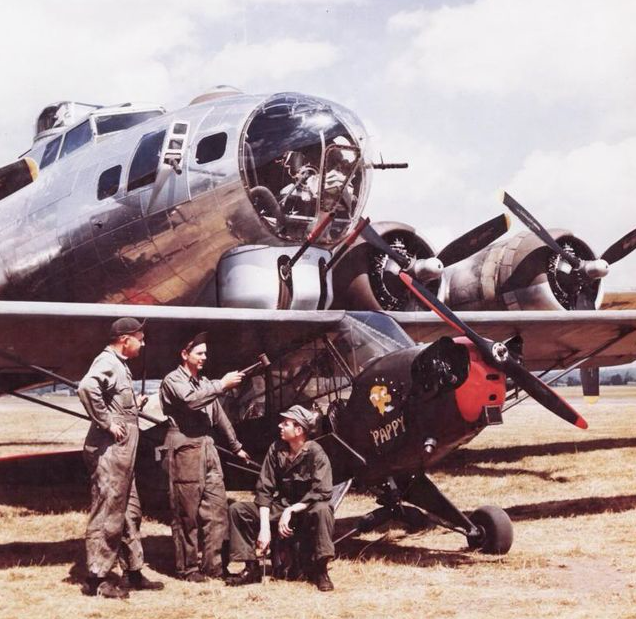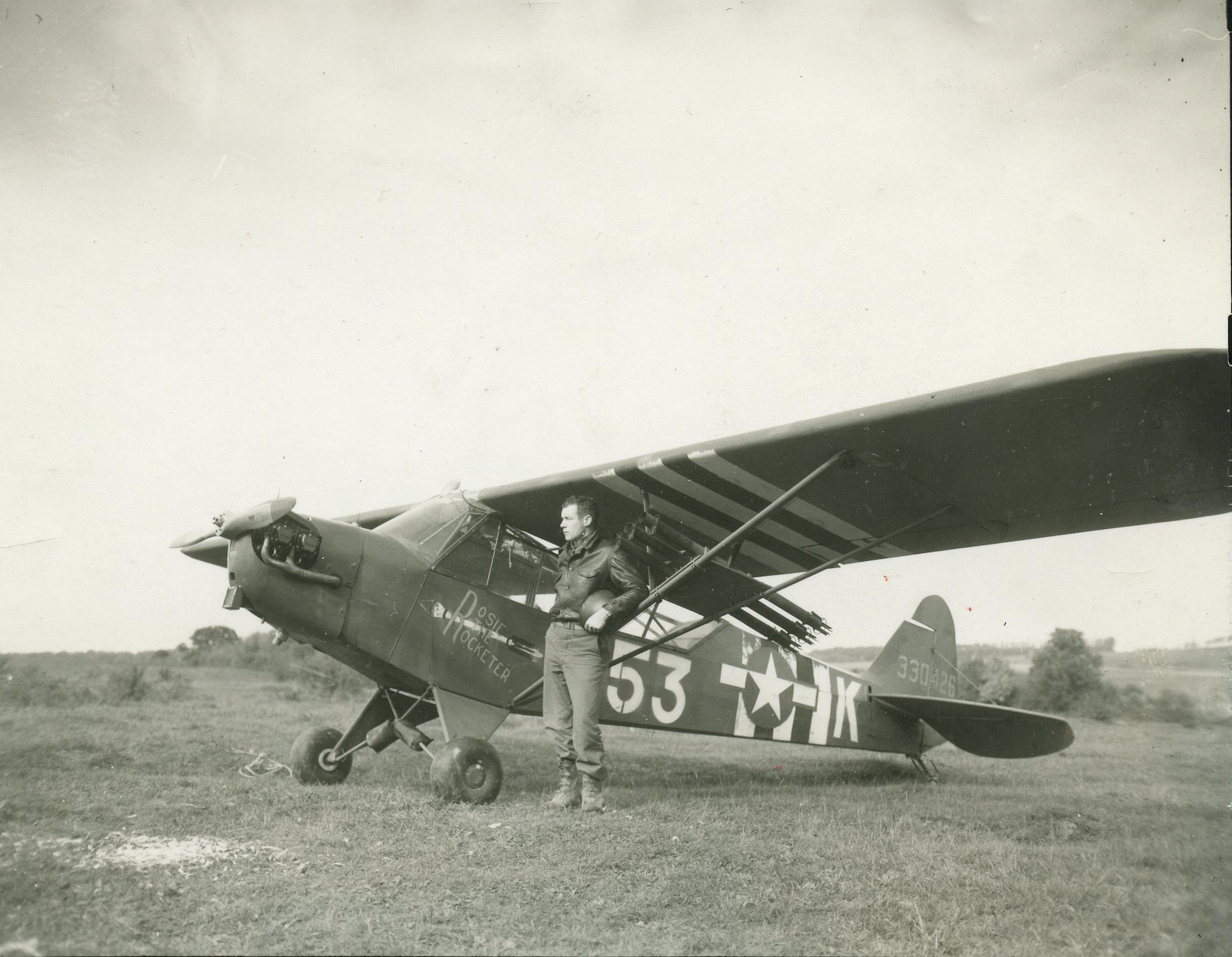L Birds
- D Day 80 - Heroes Remembered
- L Birds

A liaison aircraft (also called L-Bird) is a small, usually unarmed aircraft primarily used by military forces for artillery observation or transporting commanders and messages. The concept developed before World War II and included also battlefield reconnaissance, air ambulance, column control, light cargo delivery and similar duties. Able to operate from small, unimproved fields under primitive conditions, with STOL capabilities, most liaison aircraft were developed from, or were later used as general aviation aircraft.
These small aircraft were extensively used by all forces during WW2. The USAAF, RAF and their allies would have used Piper L4 Cubs, Stinson L-5 Sentinels, and Taylorcraft Auster aircraft.
The Germans and the Axis forces used Fieseler Fi 156 Storch, Messerschmitt Bf 108 Taifun and FW 189.
The Piper L4 Cubs were used by the Allied Forces for the Invasion of North Africa in 1942 to ‘43 during Operation Torch to spot for gunfire and reconnaissance of French positions. Most of the Piper L4’s were shot at by ‘Friendly fire’ and damaged. There was a large shortage of L-Birds during this campaign and lessons learnt were implemented later in the war during D-Day and the invasion of Italy. A need was seen for a more powerful L-Bird and hence the introduction of the 190 hp Stinson L-5.
While liaison aircraft, mainly L-5s after the spring of 1944, were used during the Italian campaign, the most extensive use occurred over the battlefields of France, Belgium, and finally Germany. From D-Day to V-E Day, they performed 97 percent of all artillery adjustment missions in the European Theatre. These aircraft were also responsible for a high percentage of battlefield observation missions, complemented in part by Army Air Forces reconnaissance planes. Due to the generally open, rolling terrain found in northwestern Europe, aerial observation and artillery spotting was relatively easy. Any German soldier who saw an enemy liaison plane in the sky knew very soon a lethal American artillery barrage would break over his head. This made German movement during daylight hours problematic.
Liaison pilots found that fields and farm roads in theatre served well as makeshift landing strips. Even in snowy conditions, which visited Western Europe with a vengeance in the winter of 1944-1945, the little planes could land almost anywhere if fitted with skis.
By the autumn of 1944
By the autumn of 1944, the tactical advantage had turned in favour of the Allies, thereby providing additional opportunities for more effective use of liaison aircraft in combat. Better coordination between friendly artillery batteries and spotter aircraft brought increasingly faster response times to fire mission requests from ground commanders. Inclement weather during late 1944 and the beginning of 1945, however, drastically reduced the effectiveness of the liaison planes. The extremely harsh weather grounded all aircraft for lengthy periods of time. Stories abounded of individual L-4 and L-5 pilots braving the elements long enough to fly fire support operations to aid beleaguered American troops, especially during the bitterly fought Battle of the Bulge between December 1944 and January 1945.
During World War II, especially in Europe, liaison planes had to deal with the threat of enemy aircraft. One of the most vociferous arguments between the Army Air Forces raised against the retention of liaison assets by the Army ground forces was the inherent vulnerability of these planes to enemy fighters. The Army Air Forces’ contention in this case was certainly correct: L-4s and L-5s were no match for the swift and deadly German fighters that they might encounter over the skies of northwestern Europe. In addition, the German high command offered what amounted to a bounty on the heads American liaison aircraft. Luftwaffe pilots were awarded various types of air medals and leave points for destroyed liaison planes.
When attacked by enemy fighters, the L-4 and L-5 pilots would dive for the deck and then fly as slowly as possible. This action would force the attackers into a stall. Recovery was almost impossible at the low altitudes the American planes were flying if the latter attempted to intercept the liaison aircraft. Liaison pilots would also try to lure enemy warbirds over the American lines, where the Germans would then have to face U.S. antiaircraft ground fire, as well as roving Yank airplanes. But the best defence against hostile planes was always remembering that discretion was the better part of valour, in other words avoiding air space containing German combat aircraft.
Some intrepid liaison skippers went looking for ways to make life difficult for the Nazis. A vivid case was the action of Major Charles “Bazooka Charlie” Carpenter, chief of the U.S. 4th Armoured Division’s reconnaissance aircraft detachment. On September 19, 1944, the opening day of a series of tank battles on the Western Front spanning 11 days and known as the Battle of Arracourt, fought in the Lorraine region of northeastern France and second only to those armoured engagements fought during the Battle of the Bulge, Major Carpenter was conducting a routine reconnaissance patrol. Seeing German tanks sneaking around a platoon of American tank destroyers, he put his L-4H into a dive and out of the rain and fog attacked the offending panzers with 2.36-inch bazooka rockets he had fitted to the fuselage of his plane. Although he failed to score any hits on the enemy armoured vehicles, his actions were enough to alert his comrades on the ground to the potential danger. The U.S. tank destroyers as a result were able to turn the tables on their would-be attackers and eliminate the advancing enemy armour. Later the same day, Carpenter once more assaulted enemy tanks, diving at an 80-degree angle and pulling up only 1,500 feet from the ground while delivering hits from his missiles on two German tanks, causing their crews to abandon both vehicles.


Innovation
Another innovative way to use the liaison planes was suggested by none other than Lt. Gen. George S. Patton, Jr. As his Third Army neared Germany’s one-mile-wide Rhine River, the western boundary of the Third Reich, he wanted to use L-4s and L-5s to airlift American troops across that waterway to secure bridgeheads on the east bank of the river. The novel scheme was only put aside when the U.S. First Army in early March was able to capture intact the large Ludendorff railway bridge over the Rhine at Remagen.
For operation from sea, the surveillance aircraft would be flown off jury-rigged flight decks made of sheets of steel matting placed over the decks of converted Navy LSTs (Landing Ship, Tank) forming a seaborne runway. This practice was first initiated during the Anzio landings on the Italian west coast in late January 1944.
Of course, once in the air the planes were not able to land back on the LSTs. The solution to this fundamental problem led to the introduction of an apparatus vital in the recovery of aircraft flown off these vessels. Named after its inventor, Army Air Force Captain James H. Brodie, the “Brodie Device” was first and only used during the fight for the island of Okinawa in April 1945. The captain’s invention consisted of four masts extended over the water from the deck of an LST and supported by a strong horizontal steel cable. A trolley with an attached sling underneath ran alongside the cable, and in turn the sling caught a hook that was attached to a moving L-4 or L-5. If properly arrested by the sling the plane would stop immediately in midair and then could then be lifted to the deck level of the LST and hoisted aboard.
“L-Bird” aircraft, although small, single-engine, slow, and unarmed, added a valuable dimension to both artillery spotting and battlefield observation during World War II. They provided artillery batteries and field commanders with much-needed information about enemy targets, positions, and movements much more rapidly than during the World War I, thus reducing the time required for artillery fire to be delivered against enemy positions. They also served well in capacities such as medical evacuation, command and control, relaying communications, and wire laying. They were easy targets for enemy air and ground fire, but the loss rate among them was minor compared to the 3,500 deployed in the war.
We aim to have 12 aircraft fly to France to be part of the special event.
The Flying Jeep – Stinson L-5. Because of its effectiveness, the L-5 was cross-utilized by the Army ground forces and Army Air Forces in Italy. A number of L-5s were flown by Army Air Forces pilots as observers to direct American fighters and fighter bombers, including P-51s and P-47s, on strafing and bombing runs. Conversely, these missions were also flown with Army liaison pilots at the controls and with Army Air Forces pilots acting as observers. These operations in Italy were known as “Horsefly” missions and were quite successful.
The Last Dog Fight of WW2 – Duane Francies. He was the kind of pilot who, when he saw something needed to be done, went in there and got it done. What he saw on April 11, 1945 was an enemy plane that needed to be taken out. the enemy plane was also an observation plane and they definitely weren’t expecting someone like Duane Francies. With his spotter Lieutenant William Martin aboard, Francies radioed, “We are about to give combat.” Then he dove down at the German Fieseler Fi-165 Storch in hot pursuit.
The German spotter gave a good chase, circling to meet them. Firing out the side doors of the Grasshopper, Francies and Martin emptied their Colt .45s into the enemy’s windshield, fuel tanks, and right wing. In total badass mode, Francies flew with his legs as he reloaded.
The Germans tipped their wing into the field and cartwheeled over. The pilot ran for cover but the observer simply fell down, thanks to a bullet lodged in his foot. Francies and Martin landed and chased the two, ultimately capturing them. Francies was even kind enough to bandage the injured observer’s foot before turning them over to the 5th Armoured.
He later recalled, “We turned them over to our tankers about 15 minutes later after the injured man thanked me many times for bandaging his foot. I think they thought we would shoot them.”
By late April, 1945, Francies had been recommended twice for the Distinguished Flying Cross, but it wasn’t until the 1966 book “The Last Battle” revisited the bizarre tale that Francies’ actually got any formal recommendation. Finally, 22 years after the fact, the brave observation pilot got his medal.
5,413 Piper L-4s were produced for U.S. & Allied forces.
The Stinson L-5 series was manufactured between November 1942 and September 1945, during which time 3,590 of the unarmed two-seaters were delivered for military service, making it the second most widely used light observation liaison aircraft of the war behind the Piper L-4 Cub.
Many Cubs and Sentinels survive today and can be found in museums all over the world and flying at airshows.
Our UK L-Birds of Blighty group intend to participate at the D-Day 80th event arranged by Aero Legends at Cherbourg, Normandy. We aim to have 12 aircraft fly to France to be part of the special event.

OUR MERCHADISE SYSTEM IS NOW 'LIVE'
Our merchandise system is now live shortly with the Official Clothing Range available to pre-order at pre-event prices for delivery at the end of October 2023